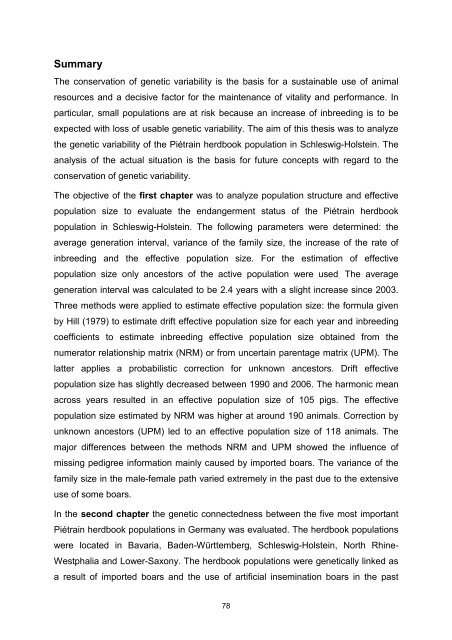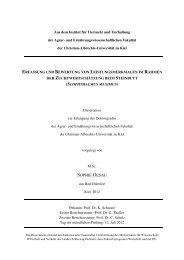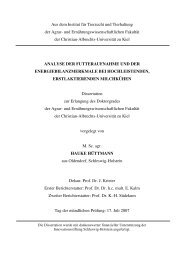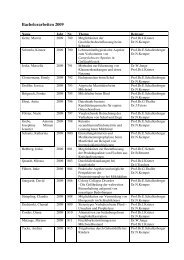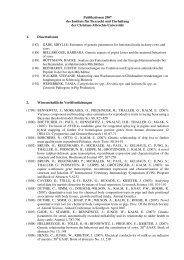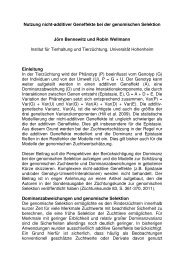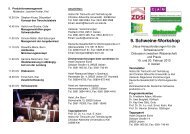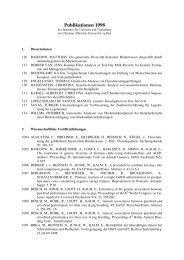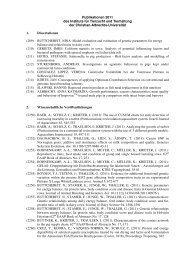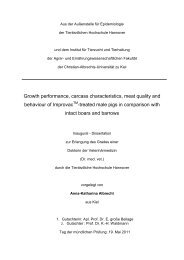Verena Gonzalez Lopez, 2011 - Institut für Tierzucht und Tierhaltung ...
Verena Gonzalez Lopez, 2011 - Institut für Tierzucht und Tierhaltung ...
Verena Gonzalez Lopez, 2011 - Institut für Tierzucht und Tierhaltung ...
Sie wollen auch ein ePaper? Erhöhen Sie die Reichweite Ihrer Titel.
YUMPU macht aus Druck-PDFs automatisch weboptimierte ePaper, die Google liebt.
Summary<br />
The conservation of genetic variability is the basis for a sustainable use of animal<br />
resources and a decisive factor for the maintenance of vitality and performance. In<br />
particular, small populations are at risk because an increase of inbreeding is to be<br />
expected with loss of usable genetic variability. The aim of this thesis was to analyze<br />
the genetic variability of the Piétrain herdbook population in Schleswig-Holstein. The<br />
analysis of the actual situation is the basis for future concepts with regard to the<br />
conservation of genetic variability.<br />
The objective of the first chapter was to analyze population structure and effective<br />
population size to evaluate the endangerment status of the Piétrain herdbook<br />
population in Schleswig-Holstein. The following parameters were determined: the<br />
average generation interval, variance of the family size, the increase of the rate of<br />
inbreeding and the effective population size. For the estimation of effective<br />
population size only ancestors of the active population were used . The average<br />
generation interval was calculated to be 2.4 years with a slight increase since 2003.<br />
Three methods were applied to estimate effective population size: the formula given<br />
by Hill (1979) to estimate drift effective population size for each year and inbreeding<br />
coefficients to estimate inbreeding effective population size obtained from the<br />
numerator relationship matrix (NRM) or from uncertain parentage matrix (UPM). The<br />
latter applies a probabilistic correction for unknown ancestors. Drift effective<br />
population size has slightly decreased between 1990 and 2006. The harmonic mean<br />
across years resulted in an effective population size of 105 pigs. The effective<br />
population size estimated by NRM was higher at aro<strong>und</strong> 190 animals. Correction by<br />
unknown ancestors (UPM) led to an effective population size of 118 animals. The<br />
major differences between the methods NRM and UPM showed the influence of<br />
missing pedigree information mainly caused by imported boars. The variance of the<br />
family size in the male-female path varied extremely in the past due to the extensive<br />
use of some boars.<br />
In the second chapter the genetic connectedness between the five most important<br />
Piétrain herdbook populations in Germany was evaluated. The herdbook populations<br />
were located in Bavaria, Baden-Württemberg, Schleswig-Holstein, North Rhine-<br />
Westphalia and Lower-Saxony. The herdbook populations were genetically linked as<br />
a result of imported boars and the use of artificial insemination boars in the past<br />
78


